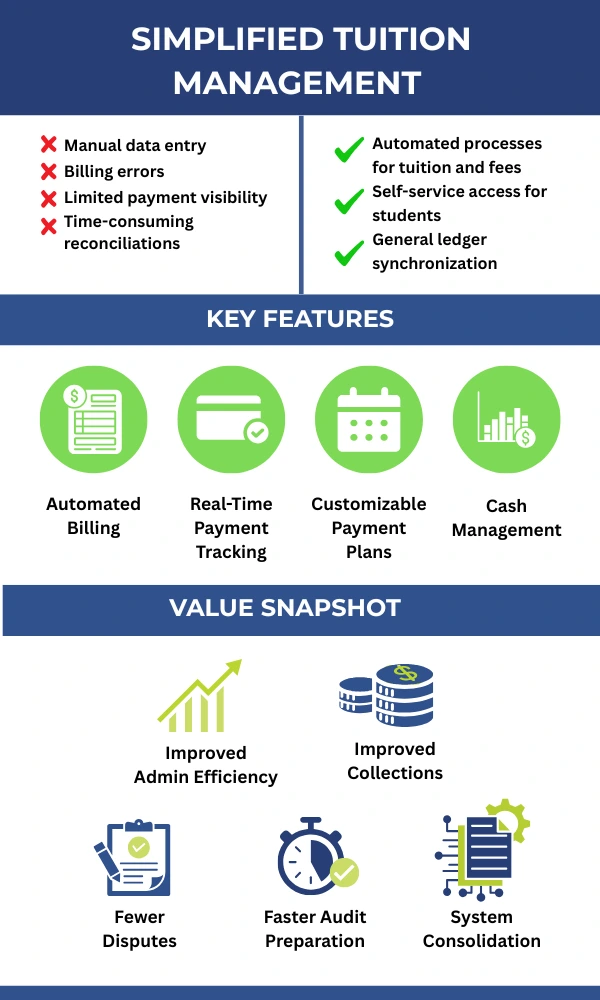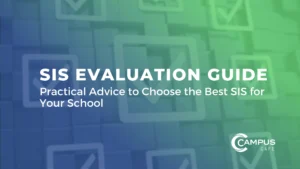
School billing software plays a central role in a school’s financial health. For finance offices, it often involves hours of repetitive work, manual entry and high risk of error. For leadership, it impacts everything from cash flow and compliance to long-term planning. When systems are outdated or disconnected, managing tuition, fees and student payments becomes more difficult than it should be. A modern, integrated solution can eliminate these inefficiencies, reduce friction and improve the overall experience for both staff and students.
A System That Supports Accuracy, Efficiency and Institutional Growth
Finance professionals such as controllers and bursars need tools that reduce manual effort, ensure accuracy and provide actionable insight. Financial aid staff rely on connected systems to properly apply awards and disbursements. Meanwhile, executive leadership is focused on long-term sustainability, enrollment health and operational ROI.
Legacy billing systems introduce challenges for all of these roles:
- Errors caused by manual data entry
- Delays in collections due to inaccurate or confusing bills
- Limited visibility into real-time account status and payment trends
- Time-consuming reconciliations and audit preparation
- Poor student experience when navigating billing and payment options
Replacing outdated systems with a comprehensive student billing management system, often integrated within broader school billing software, is one way to ensure better collaboration across departments and greater trust in financial data.
How Student Billing Connects to a Broader SIS Strategy
Billing should not operate in isolation. A school’s billing platform works best when it is part of a broader student information system (SIS) that integrates with registration, housing, financial aid and more. When data flows automatically across departments, it reduces the administrative burden and ensures that students are billed accurately based on their actual enrollment and aid status.
This is especially important as institutions strive to reduce inefficiencies across their campuses. This breakdown of how to reduce manual work dives deeper into how automation and integration can free up valuable time for finance, admissions and academic teams alike.
Key Features of a Student Finance System That Make a Difference
Learn more about these capabilities in the Student Finance overview to see how each feature supports broader school operations.
An effective student finance system provides far more than invoicing alone. The right platform should support your institution’s goals with built-in tools that work for finance teams, students and leadership. Many of these tools are core to any robust school billing software implementation.
Automated Billing
Tuition and fees are calculated based on each student’s enrollment, housing, meal plan and more. This automation eliminates the need for staff to manually calculate charges, thereby reducing errors and speeding up the processing time. You can explore this feature further in the billing section.
Real-Time Payment Tracking
Finance teams can monitor payments in real time, allowing them to take action sooner when accounts fall behind. This feature is detailed in the student payment capabilities. Executives benefit from more timely reports and greater visibility into institutional cash flow.
Customizable Payment Plans
Offering flexible payment options can help students stay enrolled while ensuring the institution remains financially stable. Automated plan management reduces time spent manually adjusting or tracking payments. This flexibility is increasingly expected in modern school billing software.
Student Self-Service Portal
Students expect digital tools that are easy to use. A secure self-service portal allows them to view balances, make payments, see financial aid and communicate with the finance office, anytime, anywhere.
General Ledger Integration
Billing data flows automatically into the general ledger, ensuring accurate accounting and easier reconciliation. You can learn more in the financial ledger overview. This feature is crucial for financial oversight and can significantly reduce audit preparation time.
Centralized Cash Management
By tracking all forms of payment, credit card, ACH, checks and more, in one place, finance teams gain a comprehensive view of cash flow. This centralized approach helps ensure transparency and efficiency. Read more about it in the cash management features.
Real-World Benefits for Teams and Leaders
Schools using modern billing solutions often report measurable improvements in accuracy, speed and collaboration. One institution reduced its billing-related admin time by over 40 percent in the first year. Others noted stronger on-time collection rates and fewer billing disputes.
Beyond operations, these improvements also support broader institutional goals:
- Finance professionals can shift focus from data entry to forecasting and analysis
- Financial aid staff can better coordinate with finance to ensure correct disbursements
- Leadership gains real-time financial insights to guide strategic planning
To learn more about how interconnected systems can drive this kind of impact, check out the Student Information System Guide.

Why the Student Experience Matters
Today’s students expect clear, user-friendly digital tools to manage their financial responsibilities. When students can’t easily access or understand their bill, they are more likely to miss payments, delay enrollment or contact staff for clarification. This not only affects collections but also increases the workload for your finance team.
A modern billing system with built-in communication tools and intuitive interfaces enhances the student experience while reducing the need for manual follow-up. When paired with an integrated CRM, schools can provide even more personalized support. If you’re exploring CRM options, this overview of how CRM can reshape college admissions is a helpful next step.
Financial ROI and Strategic Value
Beyond day-to-day improvements, modern billing software supports long-term sustainability. Reduced administrative effort, better payment collection and more accurate reporting all contribute to a stronger financial position.
Executives will appreciate benefits such as:
- Improved forecasting and budget planning
- Consolidation of systems and reduced IT overhead
- Enhanced student retention through easier payment experiences
- Greater insight into institutional financial health
If your leadership team is assessing enterprise technology investments, this guide on why your school needs an integrated CRM offers additional perspective on how centralizing systems can drive ROI.
The Bottom Line
Managing tuition and billing doesn’t need to be stressful, time-consuming or disconnected from broader institutional goals. By investing in a modern, integrated billing system, schools can support accuracy, efficiency and a better student experience.
Whether your team is trying to improve collections, reduce manual work or gain better reporting insights, a well-designed billing platform will serve both daily needs and long-term strategy.
To learn how your institution can modernize tuition management and streamline financial operations, schedule a demo with Campus Cafe and see how smarter billing can support your goals.




